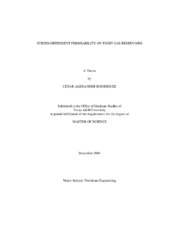| dc.description.abstract | People in the oil and gas industry sometimes do not consider pressure-dependent permeability in reservoir performance calculations. It basically happens due to lack of lab data to determine level of dependency. This thesis attempts to evaluate the error introduced in calculations when a constant permeability is assumed in tight gas reservoir. It is desired to determine how accurate are conventional pressure analysis calculations when the reservoir has a strong pressure-dependent permeability. The analysis considers the error due to effects of permeability and skin factor. Also included is the error associated when calculating Original Gas in Place in the reservoir. The mathematical model considers analytical and numerical solutions of radial and linear flow of gas through porous media. The model includes both the conventional method, which assumes a constant permeability (pressure-independent), and a numerical method that incorporates a pressure-dependent permeability. Analysis focuses on different levels of pressure draw down in a well located in the center of a homogeneous reservoir considering two types of flow field geometries: radial and linear. Two different producing control modes for the producer well are considered: constant rate and constant bottom hole pressure. Methodology consists of simulated tight gas well production with k(p) included. Then, we analyze results as though k(p) effects were ignored and finally, observe errors in determining permeability (k) and skin factor (s). Additionally, we calculate pore volume and OGIP in the reservoir. Analysis demonstrates that incorporation of pressure-dependence of permeability k(p) is critical in order to avoid inference of erroneous values of permeability, skin factor and OGIP from well test analysis of tight gas reservoirs. Estimation of these parameters depends on draw down in the reservoir. The great impact of permeability, skin factor and OGIP calculations are useful in business decisions and profitability for the oil company. Miscalculation of permeability and skin factor can lead to wrong decisions regarding well stimulation, which reduces well profitability. In most cases the OGIP calculated is underestimated. Calculated values are lower than the correct value. It can be taken as an advantage if we consider that additional gas wells and reserves would be incorporated in the exploitation plan. | en |


